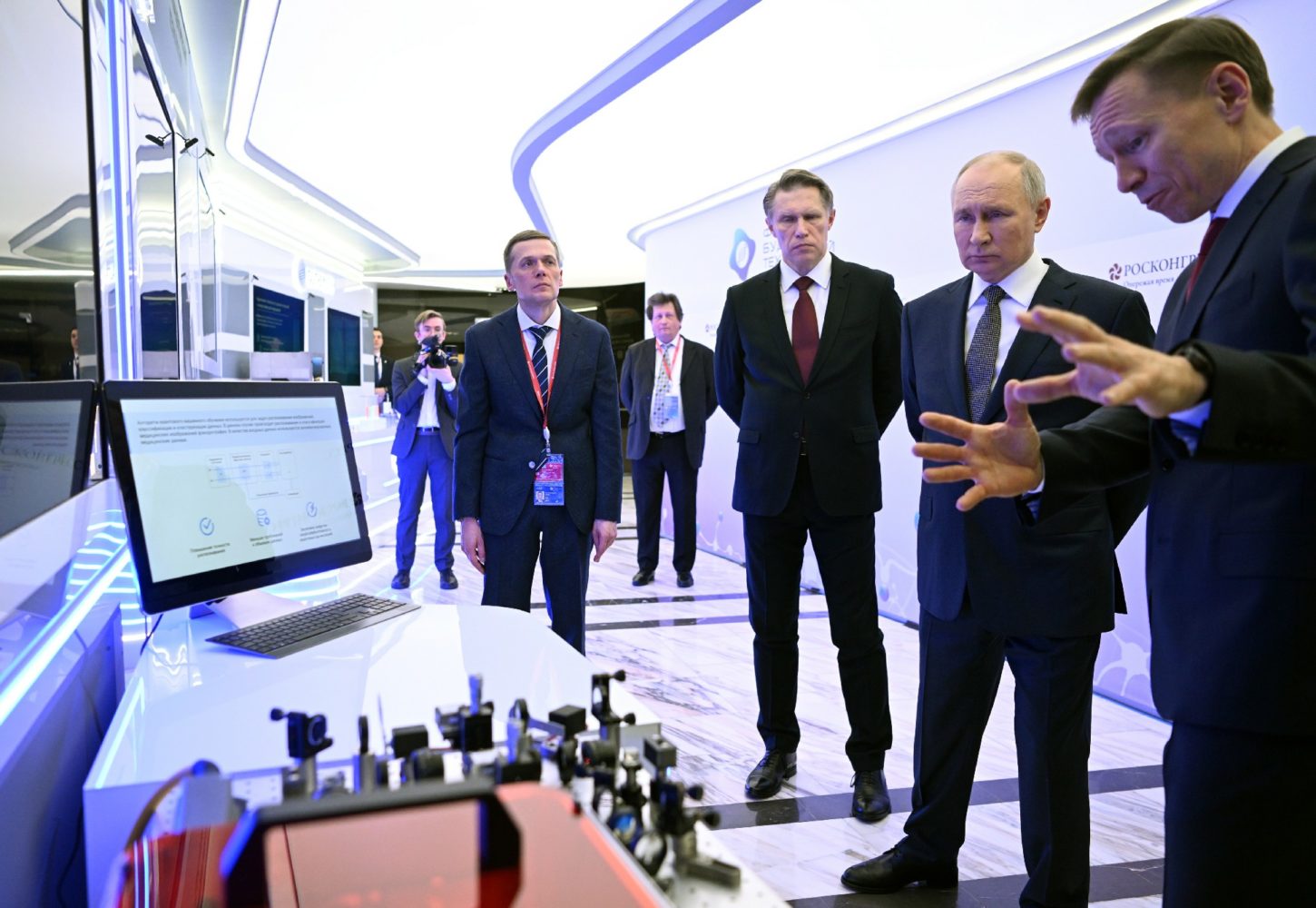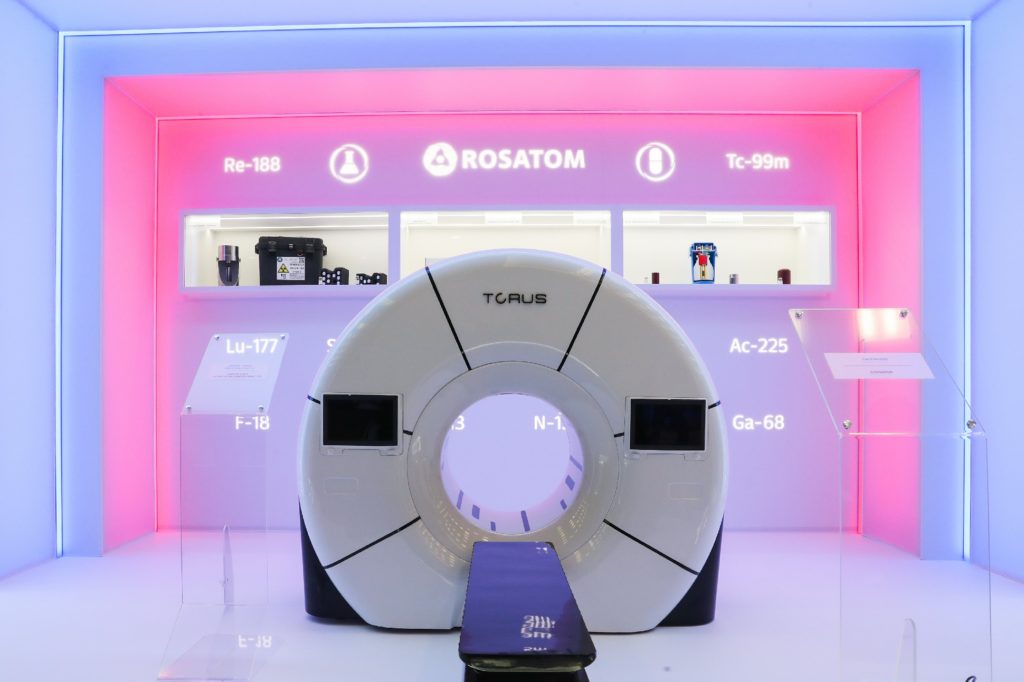
Nuclear Technology for Healthy Living
back to contentsIn February, Rosatom took part in the Future Technologies Forum to present its latest developments in medicine, including 3D-printed organ samples, radiopharmaceuticals, and quantum algorithms for medical applications. Members of the BRICS Working Group on Nuclear Medicine shared their experience, discussed challenges, and proposed solutions.
Exhibits from the future
Held in Moscow for the second time, this year’s Future Technologies Forum was dedicated to medical solutions. The first forum held last year dealt with quantum technology. Rosatom, however, extended quantum technology into medicine. The visitors to the Russian nuclear corporation’s booth had an opportunity to learn about a quantum algorithm capable of detecting early signs of pneumonia on X-ray images, and see pre-production samples of laser units and electronic modules for quantum computing, which are being tested in the laboratories of the Russian Quantum Center.
Custom-made and standardized implants printed with 3D MRI or CT images were another product developed and presented by Rosatom. The implants are covered with an osteotropic antibacterial material, so they fuse with the bone much better. These solutions reduce implant production time from 60 to 7 days and help patients recover 2–3 times faster.
The world’s leading supplier of radioisotope products, Rosatom also demonstrated mock-ups of its radiopharmaceutical products, iodine 125 microsources, ophthalmic applicators containing ruthenium 106 and strontium 90 (Rosatom is the only manufacturer of these products worldwide), and a compact rhenium 188 generator GREN 1. The nuclear corporation is currently building Europe’s largest radiopharmaceuticals factory in Obninsk (Kaluga Region) to expand its production and cover the entire range of radiopharmaceuticals used in global medical practice.
The most interesting exhibit was, perhaps, a mock-up of a bioprinter that uses magnetic and acoustic fields to grow tubular tissues (such as vessels), and a bioreactor in which vessels ‘learn’ to function properly. The device uses the patient’s cells to bioprint small-diameter blood vessels. Such vessels then grow together with the body, which is of critical importance in pediatric transplantology. Rosatom researchers have grown a 2 cm long vessel and plan to obtain samples up to 10 cm long by the end of the year. As the next step, they will attempt to grow complex systems and organs.
“Rosatom Group companies are conducting research in additive technology, radiopharmaceuticals and quantum computing for the needs of the healthcare sector. These efforts are aimed at significantly expanding doctors’ ability to help patients. Our research is designed to bring healthcare to a completely new level and achieve a totally different quality of life for people,” Rosatom Director General Alexey Likhachev said.
Joining efforts
The Future Technologies Forum hosted a meeting of the BRICS Working Group on Nuclear Medicine. The meeting was opened by Kirill Komarov, First Deputy Director General for Corporate Development and International Business at Rosatom. He noted that interest in nuclear medicine was growing on the back of the rising number of cancer patients and cancer-related deaths. With radionuclide imaging equipment improving and more effective radiopharmaceuticals for diagnostics and therapy developed, the capabilities of nuclear medicine are becoming increasingly wider. In addition to oncology, radionuclide imaging is used in cardiology, neurology and other areas of medicine.
BRICS is expanding and strengthening ties between its member countries. There are nine of them now as Brazil, Russia, India, China and South Africa have been joined by the UAE, Iran, Egypt and Ethiopia, with more countries looking forward to joining the organization.
Representatives of the BRICS countries spoke about the situation in nuclear medicine. In Egypt, for example, most nuclear medicine facilities are located in Cairo and Alexandria. The country with a population of 110 million has at least 85 SPECT machines and 80 PET and CT scanners. Egypt produces technetium 99m, fluorine 18 and iodine 131, and imports gallium 68, yttrium 90 and lutetium 177.
The 120 million Ethiopia possesses 12 SPECT machines and 4 PET/CT scanners located at six institutions. The country is planning to build its own isotope production capacity, for which purpose Ethiopia has developed the design of a cyclotron and conducted a pre-feasibility study for a research reactor. The country has only 35 people working in nuclear medicine, one of whom has already retired. Unfortunately, training programs for nuclear medicine specialists are very poor, so the staffing issue is one of the most critical in the country.

Iran has been practicing nuclear medicine since 1960. Currently, there are 220 nuclear medicine centers in the country. Iran produces 66 different radiopharmaceuticals, with over 40 of them produced on a daily or weekly basis. Drugs based on lutetium 177, microspheres and applicators containing yttrium 90, and other radiopharmaceuticals are undergoing clinical trials. Iran plans to produce radionuclide-containing substances in accordance with GMP standards, launch a 70 MeV cyclotron and a 10 MW high-flux reactor, and produce molybdenum 99 using targets irradiated in the Tehran Research Reactor.
South Africa produces and uses a dozen isotopes for medical purposes, and also helps neighboring Ghana. In 2023, the country opened a radionuclide therapy center. The plans for the future include developing therapeutic services, opening new therapy centers, and training staff, including through increased cooperation and improved supply.
India already uses carbon, fluorine, nitrogen and technetium isotopes and considers terbium isotopes to be promising for theranostics (diagnostics and therapy with one radioactive substance). India plans to develop theranostics and targeted alpha therapy for chemoresistant tumors, early diagnosis of Alzheimer’s disease with radionuclide imaging, personnel training, and isotope production technology.
Almost every member of the working group spoke about the need for cooperation in staff training, expanding the range of radiopharmaceuticals, and accelerating delivery of isotopes and radionuclide products. The discussion of these challenges will continue at the 1st BRICS Expert Forum on Nuclear Medicine to be held in Saint Petersburg on June 20–21.
“Russia and other countries that are now part of the BRICS economic space have great potential in nuclear medicine. We are confident that cooperation between the partner countries will consolidate efforts to more effectively put nuclear medicine solutions into medical practice,” Kirill Komarov said in conclusion.




